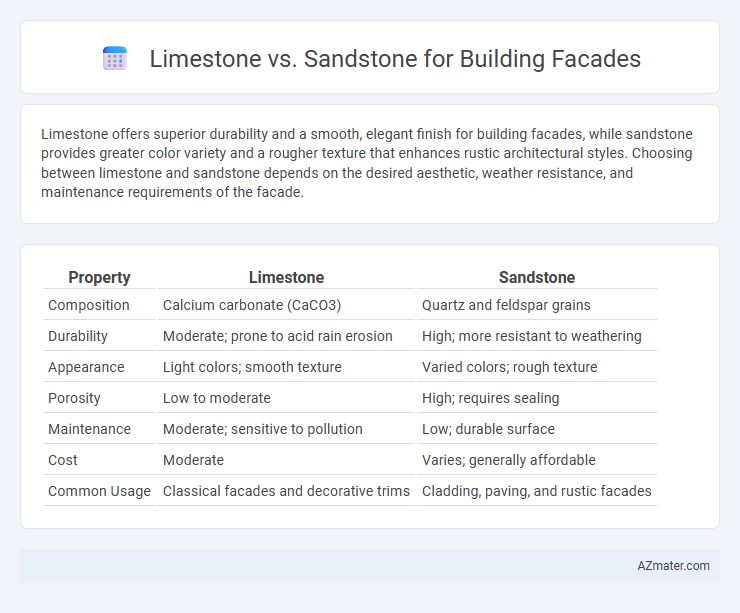Limestone offers superior durability and a smooth, elegant finish for building facades, while sandstone provides greater color variety and a rougher texture that enhances rustic architectural styles. Choosing between limestone and sandstone depends on the desired aesthetic, weather resistance, and maintenance requirements of the facade.
Table of Comparison
| Property | Limestone | Sandstone |
|---|---|---|
| Composition | Calcium carbonate (CaCO3) | Quartz and feldspar grains |
| Durability | Moderate; prone to acid rain erosion | High; more resistant to weathering |
| Appearance | Light colors; smooth texture | Varied colors; rough texture |
| Porosity | Low to moderate | High; requires sealing |
| Maintenance | Moderate; sensitive to pollution | Low; durable surface |
| Cost | Moderate | Varies; generally affordable |
| Common Usage | Classical facades and decorative trims | Cladding, paving, and rustic facades |
Overview: Limestone vs Sandstone for Building Facades
Limestone offers a smooth texture and uniform appearance, making it ideal for elegant and classical building facades, while sandstone provides greater color variety and natural grain patterns that enhance rustic or contemporary designs. Limestone tends to be more durable and weather-resistant in urban environments, whereas sandstone may require additional sealing to prevent erosion and staining over time. Both materials are widely used for their aesthetic appeal and structural properties, but choice depends on climate, maintenance, and architectural style preferences.
Geological Composition and Characteristics
Limestone, primarily composed of calcium carbonate from marine organisms, offers a dense, durable surface with a fine texture suitable for intricate carving, making it ideal for detailed architectural facades. Sandstone consists mainly of quartz and feldspar grains bound by natural cements like silica or calcite, providing a porous, weather-resistant material with varied color and grain size that enhances aesthetic versatility. Both stones exhibit distinct porosity and hardness levels influencing their durability and maintenance needs in exterior building applications.
Aesthetic Differences: Color and Texture
Limestone offers a smooth, fine-grained texture with a palette ranging from creamy white to soft beige, providing a classic and elegant aesthetic for building facades. Sandstone features a coarser texture and exhibits a broader spectrum of warm earth tones, including reds, browns, and yellows, contributing to a rustic and natural appearance. The color uniformity of limestone contrasts with the varied, stratified look of sandstone, influencing architectural styles and visual impact.
Durability and Weather Resistance
Limestone offers moderate durability with a tendency to weather and erode in acidic or polluted environments, making it suitable for regions with mild climates. Sandstone provides superior weather resistance due to its dense composition and natural grain structure, allowing it to withstand freeze-thaw cycles and heavy rainfall more effectively. Choosing between limestone and sandstone for building facades depends on the specific environmental conditions and long-term maintenance requirements of the project location.
Maintenance Requirements and Longevity
Limestone facades generally require more frequent maintenance due to their porous nature, making them susceptible to erosion and staining from pollution and moisture. Sandstone offers better durability and weather resistance, resulting in lower maintenance needs and a longer lifespan, especially in harsh climates. Choosing sandstone can provide enhanced longevity for building exteriors, reducing long-term upkeep costs compared to limestone.
Workability: Cutting and Installation
Limestone offers superior workability for building facades due to its uniform texture and softness, making cutting and carving easier compared to sandstone. Sandstone, while durable, has a more granular composition that can challenge precision cutting and requires specialized tools for installation. Efficient facade construction benefits from limestone's consistency, reducing labor time and ensuring smoother installation processes.
Cost Comparison: Limestone vs Sandstone
Limestone generally commands a higher price than sandstone due to its greater density and durability, with costs ranging from $30 to $50 per square foot compared to sandstone's typical $20 to $40 per square foot. The installation of limestone often involves more labor-intensive processes, further increasing overall expenses. Sandstone offers a more budget-friendly option for building facades while still providing adequate weather resistance and aesthetic appeal.
Environmental Impact and Sustainability
Limestone and sandstone both offer varying environmental impacts and sustainability profiles for building facades, with limestone generally having a lower embodied energy due to its abundance and easier quarrying process, resulting in reduced carbon emissions. Sandstone, on the other hand, often requires more intensive extraction and processing, which can lead to higher environmental costs but provides exceptional durability and thermal insulation, potentially enhancing long-term energy efficiency of buildings. Selecting limestone or sandstone requires balancing the immediate environmental footprint with lifecycle benefits, emphasizing sustainable sourcing, local availability, and potential for reuse or recycling in facade construction.
Popular Architectural Applications
Limestone is widely favored for building facades due to its fine texture, durability, and ability to be intricately carved, making it ideal for classical and historic architectural applications such as cathedrals and government buildings. Sandstone, known for its natural layering and warm hues, is commonly used in residential and commercial facades to achieve a rustic, natural aesthetic popular in Southwestern and Victorian-style architecture. Both materials offer weather resistance and color variation, but limestone's smoother surface contrasts with sandstone's granular texture, influencing design choices in urban and heritage projects.
Choosing the Right Stone for Your Building Facade
Limestone offers a smooth texture and natural durability, making it ideal for classic, elegant building facades that require resistance to weather and environmental wear. Sandstone provides a unique, coarse grain and rich color variations, lending character and warmth to facades in both traditional and contemporary architecture. Selecting between limestone and sandstone depends on factors like climate, maintenance needs, structural support, and desired aesthetic impact for the building's exterior.

Infographic: Limestone vs Sandstone for Building Facade
 azmater.com
azmater.com